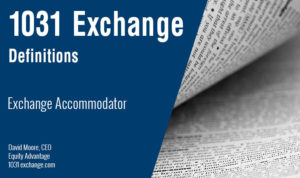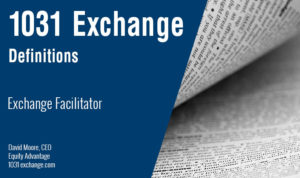In a recent conversation hosted by David and Tom Moore, known in the 1031 community as The Exchange Bros, two guests, Forrest James of Emerson Equity and Derek Vogel of Appreciation Homes, outlined a new 1031 Exchange alternative built around a fresh structure called the Direct Title Security, or DTS.
Unlike traditional Delaware Statutory Trusts (DSTs), DTS investments are structured to provide what many investors feel has been missing in passive real estate: control, liquidity, and stable, mailbox-money income, all while remaining 1031-exchange compliant.
This article explains the DTS structure, how it works, and why it is positioned as a conservative, control-focused alternative for a 1031 exchange.
Why DTS Was Created: Solving Control and Liquidity Gaps in DSTs
Forrest James introduced the origin story: the idea for DTS began nearly eight years earlier after years of observing the limitations of DSTs. DSTs are widely used and provide diversification, but repeatedly investors struggled with two major issues:
- Lack of control
- Limited liquidity
In DSTs, a sponsor controls the property, the timing, financing, and the exit. Investors cannot refinance, cannot pull cash out, cannot change loan terms, and often cannot sell until the sponsor chooses an exit, typically four to seven years. Many appreciate this fixed structure, but others want more flexibility.
Forrest sought a structure that preserved the passive nature of DSTs but restored owner control. After attempts with smaller and then larger real estate operators, the right model finally came together through a collaboration with Appreciation Homes, and Emerson Equity became the managing broker dealer.
The result was the Direct Title Security, combining fee simple home ownership with features usually seen only in commercial triple net properties.
What a DTS Is: Direct Ownership Plus a Long Term Master Lease
A Direct Title Security gives investors fee simple, direct title ownership of one or more single family homes. Unlike DSTs where investors buy fractional interests, here the investor owns the homes outright.
Each property comes with a long term credit tenant lease, typically 10 years. Appreciation Homes serves as the master tenant, not the physical occupant. They place subtenants and handle all property level management through a national third party management firm that oversees tens of thousands of homes.
Each DTS uses a quadruple net lease. Appreciation Homes covers taxes, insurance, maintenance, vacancy risk, and even roof and structural expenses. This setup provides the passivity of commercial triple net leases but with residential assets that tend to be more liquid and easier to sell
How the Lease Structure Protects Investors
If Appreciation Homes ever failed as a company, investors would still own the property, likely have a subtenant already in place, and directly control the asset going forward. In that case, the property does not become trapped or lost. It simply becomes a standard rental home the investor can continue operating or selling.
This differs from DSTs, where the sponsor has total control and the investor is fully dependent on the sponsor’s decisions.
Property Types and Markets
DTS properties are primarily new construction, Class A single family homes, usually one to three years old, built by large regional or national homebuilders.
Most inventory is located in Sun Belt markets, including Alabama, Georgia, Florida, Texas, Tennessee, and Oklahoma. However, if an investor wants homes in other qualifying markets, such as Arizona or Ohio, Appreciation Homes can source properties and place leases as needed.
If a client is mid exchange and needs properties quickly, portfolios can usually be assembled within 48 hours, though closings take longer, about two weeks for cash and four weeks for transactions using financing.
Customization Based on Investor Goals
Each DTS is fully customizable. A portfolio may consist of one to fifteen homes, depending on the investor’s goals. Properties can be selected to target higher income or higher appreciation.
Typical investor returns discussed were between 4 and 5 percent cash flow and 7 to 9 percent total return over a ten year hold period. Since each DTS holds specific homes, returns vary by market and property type.
Closing Timelines and 1031 Exchange Compatibility
DTS is fully 1031 compliant. Identification of properties usually takes 48 hours. Closings require about two weeks for all cash purchases or four weeks with financing. Although not as fast as a DST, which can close within 24 hours, these timelines fit comfortably within 1031 deadlines.
Investors identify specific property addresses, making the identification step clear and simple
Financing and Liquidity Options
A major feature of DTS is the flexibility with debt. Investors can buy with cash and add debt later through a cash out refinance, which is not possible in DSTs. They can also add debt before closing through a white label, non-recourse lender associated with the DTS program.
Loans are typically available up to 65 percent loan to value and are non-recourse. Payments are taken directly from the net lease income, which eliminates the risk of borrower default.
Liquidity is enhanced because investors can sell anytime, and they can refinance to access capital without selling or triggering taxes.
Minimum Investment and Requirements
A DTS investment begins with purchasing a single home, typically between 250,000 and 500,000 dollars. With financing, an investor can enter with as little as 100,000 dollars in cash. DTS offerings require investors to be accredited since they are structured as Reg D 506c securities.
Who DTS Is Designed For
DTS is positioned for several investor types:
- 1031 exchange investors seeking more control
- Investors who want fee simple ownership without active management
- Investors seeking passive, predictable income
- Investors needing access to capital
- Advisors or real estate brokers working with clients who prefer direct ownership
A Hybrid Approach to Modern 1031 Investing
The DTS model brings together the strongest aspects of triple net commercial real estate, the passive structure of DSTs, and the flexibility of direct home ownership. It aims to provide safety, stability, and optionality for investors navigating changing real estate markets.
The Guys With All The Answers…
 David and Thomas Moore, the co-founders of Equity Advantage & IRA Advantage
David and Thomas Moore, the co-founders of Equity Advantage & IRA Advantage
Whether working through a 1031 Exchange with Equity Advantage, acquiring real estate with an IRA through IRA Advantage or listing investment property through our Post 1031 property listing site, we are here to help Investors get where they want to be. Call them today! 503-635-1031.









